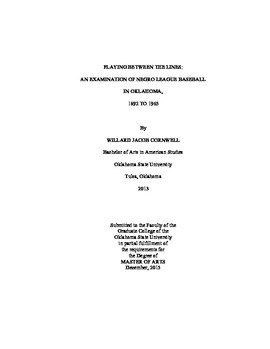| dc.contributor.advisor | Bryans, William S. | |
| dc.contributor.author | Cornwell, Willard Jacob | |
| dc.date.accessioned | 2016-09-29T18:44:25Z | |
| dc.date.available | 2016-09-29T18:44:25Z | |
| dc.date.issued | 2015-12-01 | |
| dc.identifier.uri | https://hdl.handle.net/11244/45346 | |
| dc.description.abstract | When Oklahoma settlers staked their claims after the land rush in the late nineteenth century, they also brought along the sport of baseball. The game of innings rapidly became an integral part of recreation throughout the red dirt and oil producing plains and hills. Despite Oklahoma becoming the last American �melting pot� for diverse cultures, the forty-sixth state also quickly established segregation when legislators� first order of business instituted Jim Crow. Baseball served as a buffer for black athletes to navigate the social hierarchy and to display their athleticism, often in segregated ballparks. The sport also inspired African-American fans when they witnessed their hometown nine triumph over other black or white teams in front of mixed-race crowds. Achievements on the ballfield boosted a Negro Leaguer�s ability to �play between the lines� and occasionally transcend prejudice and overcome adversity. Although Oklahoma African-American ballclubs never joined the �black majors,� Negro National or American Leagues, they exhibited professionalism in organized regional leagues and demonstrated proficiency on the diamond throughout the years of widespread segregation. Using Tulsa as a case study, this work examines the role of black baseball in many Oklahoma cities and towns and in nearby states where �Okies� played. Teams across the state, particularly in Oklahoma City and Tulsa, regularly nurtured and matured young talent for the Negro major leagues and became a place for aging black big leaguers to extend their careers. Ballclub owners also regularly recruited talented athletes throughout the region and across the country. Several organizers, promoters, and owners showed great business acumen for assembling competitive teams and for negotiating the tricky and racially-divided environment to provide ballpark venues and fields for play. Technology now enables researchers with tools to further explore black baseball history. Modern instruments like Ground Penetrating Radar (GPR) can aid historians, preservationists, and geographers in non-destructive ways to probe sites where Oklahoma Negro Leaguers played in Tulsa and beyond. Exposing the past by utilizing burgeoning technology augments the understanding of baseball�s vital role in African-American communities during segregation, and how it provided them with a sense of place. | |
| dc.format | application/pdf | |
| dc.language | en_US | |
| dc.rights | Copyright is held by the author who has granted the Oklahoma State University Library the non-exclusive right to share this material in its institutional repository. Contact Digital Library Services at lib-dls@okstate.edu or 405-744-9161 for the permission policy on the use, reproduction or distribution of this material. | |
| dc.title | Playing Between the Lines: An Examination of Negro League Baseball in Oklahoma, 1892 to 1965 | |
| dc.type | text | |
| dc.contributor.committeeMember | Moses, L. G. | |
| dc.contributor.committeeMember | Carreiro, Amy | |
| dc.contributor.committeeMember | Finchum, Allen | |
| osu.filename | Cornwell_okstate_0664M_14442.pdf | |
| osu.accesstype | Open Access | |
| dc.description.department | History | |
| dc.type.genre | Thesis | |
